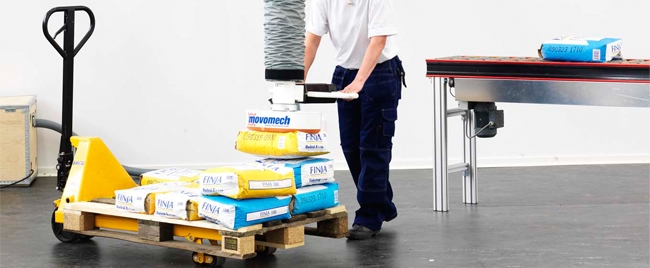What is a Vacuum Lifter?
Vacuum lifters are ergonomic devices used to transport a variety of products within a set area, such as a warehouse or a manufacturing facility. From heavy box handling to sack and bag handling to delicate glass manoeuvring, ergonomic vacuum lifters can serve many needs. Vacuum lifters can be as basic as a handheld suction cup or as complex as a pump-powered, multi-pad end effector. Each unit is often designed with different applications in mind and uses a range of attachments and power options to safely lift products.
Types of Vacuum Lifters:
There are many types of vacuum lifters. Choices can include heavy-duty lifters, vertical-horizontal lifters, electric-powered lifters, battery-powered lifters and products with mobile attachments.
Heavy-Duty: Vacuum lifters are made with oversized lifting frames, vacuum pads, and vacuum stations. They are designed to handle materials and products such as metal plates.
Vertical-Horizontal: Vacuum lifters can hold a load in place either vertically or horizontally, depending on the application requirements.
Electric-Powered: Vacuum lifters feature high capacity pumps, valves, filters and gauges for trouble-free operation in the most demanding production environments.
Battery-Powered: Vacuum lifters are commonly used for special applications where AC power is not readily available below the hook as there is a rechargeable battery.
Mobile Attachment: Vacuum lifters are suitable for use with forklifts, excavators and other end-effector equipment.
Benefits of a Vacuum Lifting Solution Include:
Drastic reduction in heavy/repetitive lifting
Can be customized for your specific application and designed to work with your specific product(s)
Reduction in workplace illness / injury claims, resulting in lower insurance costs
Allows for diversity/adaptability on the job, more workers are now able to complete the task without physical limitations being an issue
They often pay for themselves through productivity and efficiency increases
Weight and capacity ranges are considered during the design process and they can often handle multiple weights, textures and products without needing to alter the system
Power Mechanisms:
Vacuum lifters can operate using four different types of mechanisms: pneumatic, hydraulic, electric, or mechanical power. Pneumatic or air-powered vacuum lifters are equipped with air cylinders or motors that provide lifting action. Hydraulic vacuum lifters are driven by an external hydraulic cylinder or motor. Electric-powered vacuum lifters have an electric motor and feature a screw / scissor combination. Mechanical or self-powered vacuum lifters that do not require electrical or compressed air services are also available.
Things to Remember:
Selecting the correct vacuum lifter for your application requires an analysis of your material-handling requirements and load orientation. The type, dimensions and temperature of the material that needs to be moved are also important considerations because vacuum lifters are designed to handle materials of varying specifications and conditions.
When it comes to load orientation there are many choices such as horizontal, vertical, side-gripping and angled tilting. Vertical lifters and side grippers may or may not rotate the load. Vacuum lifters with 90-degree tilting are often fully powered. In quarrying applications, 90-degree gravity tilting units with pivots are used. Vacuum lifters with a 180-degree or 360-degree are also options depending on your application. Side grippers come in many styles and may be used instead of flippers to provide 360-degree rotation.
The best way to determine the correct vacuum lifter for your application is to contact a material handling specialist to help you determine your material handling requirements.
Can you think of another type of vacuum lifter? Do you know of another benefit that vacuum lifters provide? Comment below!


